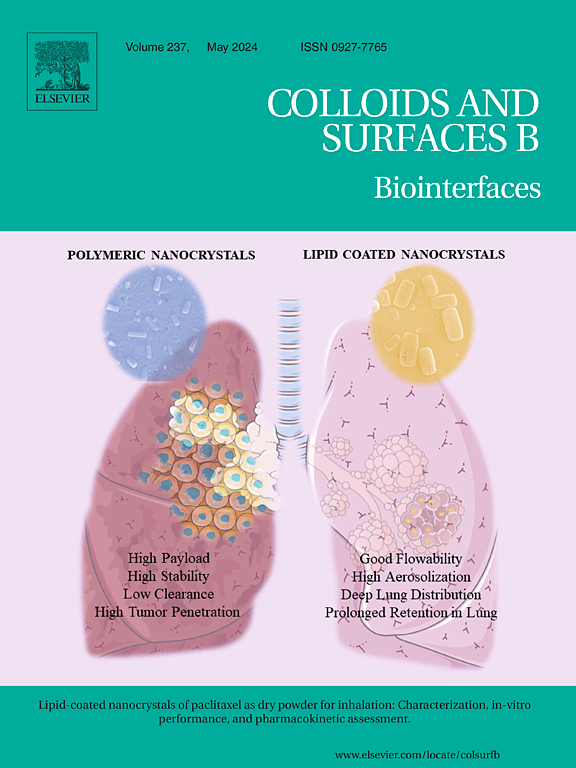Bismuth-based mesoporous nanoball carrying sorafenib for synergistic photothermal and molecularly-targeted therapy in an orthotopic hepatocellular carcinoma xenograft mouse model
IF 5.4
2区 医学
Q1 BIOPHYSICS
引用次数: 0
Abstract
Sorafenib (SOR), a multi-kinase inhibitor for advanced hepatocellular carcinoma (HCC), has limited clinical application due to severe side effects and drug resistance. To overcome these challenges, we developed a bismuth-based nanomaterial (BOS) for thermal injury-assisted continuous targeted therapy in HCC. Initially, the mesoporous nanomaterial was loaded with SOR, forming the BOS@SOR nano-carrier system for drug delivery and controlled release. Notably, compared to targeted or photothermal therapy alone, the combination therapy using this nano-carrier system significantly impaired cell proliferation and increased apoptosis. In vivo efficacy evaluations demonstrated that BOS@SOR exhibited excellent biocompatibility, confirmed through hemolysis and biochemical analyses. Additionally, BOS@SOR enhanced contrast in computed tomography, aiding in the precise identification of HCC size and location. The photothermal therapeutic properties of bismuth further contributed to the synergistic anti-tumor activity of BOS@SOR, significantly reducing tumor growth in an orthotopic xenograft HCC model. Taken together, encapsulating SOR within a bismuth-based mesoporous nanomaterial creates a multifunctional and environmentally stable nanocomposite (BOS@SOR), enhancing the therapeutic effect of SOR and presenting an effective strategy for HCC treatment.
铋基介孔纳米球携带索拉非尼,在正位肝细胞癌异种移植小鼠模型中用于协同光热和分子靶向治疗。
索拉非尼(SOR)是一种治疗晚期肝细胞癌(HCC)的多激酶抑制剂,但由于其严重的副作用和耐药性,其临床应用十分有限。为了克服这些挑战,我们开发了一种铋基纳米材料(BOS),用于热损伤辅助的 HCC 连续靶向治疗。首先,在介孔纳米材料中负载 SOR,形成 BOS@SOR 纳米载体系统,实现药物的输送和控释。值得注意的是,与单独的靶向治疗或光热治疗相比,利用这种纳米载体系统进行的联合治疗能显著抑制细胞增殖并增加细胞凋亡。体内疗效评估表明,BOS@SOR 具有良好的生物相容性,溶血和生化分析证实了这一点。此外,BOS@SOR 还增强了计算机断层扫描的对比度,有助于精确确定 HCC 的大小和位置。铋的光热治疗特性进一步促进了 BOS@SOR 的协同抗肿瘤活性,显著降低了正位异种移植 HCC 模型中肿瘤的生长。综上所述,将 SOR 包封在铋基介孔纳米材料中形成了一种多功能、环境稳定的纳米复合材料(BOS@SOR),增强了 SOR 的治疗效果,为 HCC 治疗提供了一种有效的策略。
本文章由计算机程序翻译,如有差异,请以英文原文为准。
求助全文
约1分钟内获得全文
求助全文
来源期刊

Colloids and Surfaces B: Biointerfaces
生物-材料科学:生物材料
CiteScore
11.10
自引率
3.40%
发文量
730
审稿时长
42 days
期刊介绍:
Colloids and Surfaces B: Biointerfaces is an international journal devoted to fundamental and applied research on colloid and interfacial phenomena in relation to systems of biological origin, having particular relevance to the medical, pharmaceutical, biotechnological, food and cosmetic fields.
Submissions that: (1) deal solely with biological phenomena and do not describe the physico-chemical or colloid-chemical background and/or mechanism of the phenomena, and (2) deal solely with colloid/interfacial phenomena and do not have appropriate biological content or relevance, are outside the scope of the journal and will not be considered for publication.
The journal publishes regular research papers, reviews, short communications and invited perspective articles, called BioInterface Perspectives. The BioInterface Perspective provide researchers the opportunity to review their own work, as well as provide insight into the work of others that inspired and influenced the author. Regular articles should have a maximum total length of 6,000 words. In addition, a (combined) maximum of 8 normal-sized figures and/or tables is allowed (so for instance 3 tables and 5 figures). For multiple-panel figures each set of two panels equates to one figure. Short communications should not exceed half of the above. It is required to give on the article cover page a short statistical summary of the article listing the total number of words and tables/figures.
 求助内容:
求助内容: 应助结果提醒方式:
应助结果提醒方式:


